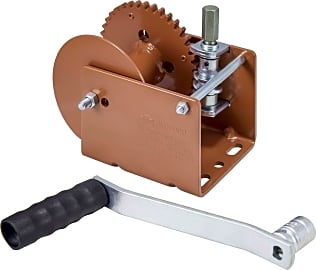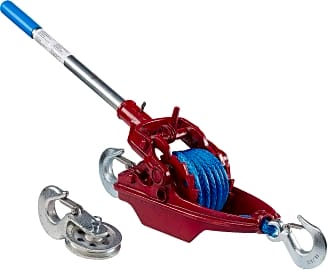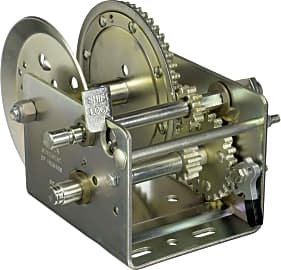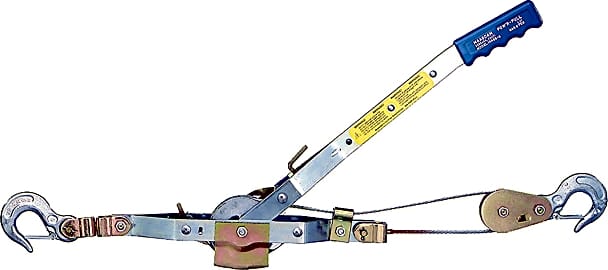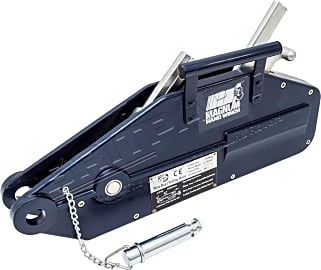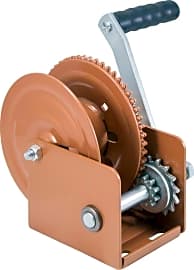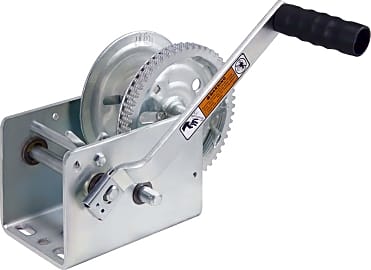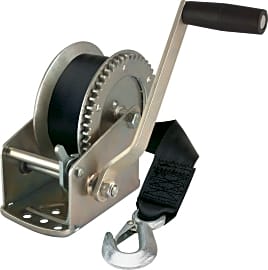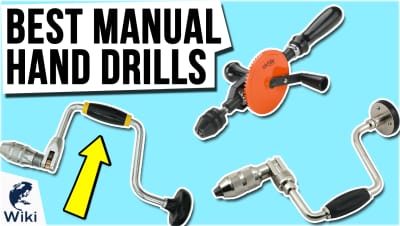The 10 Best Hand Winches

This wiki has been updated 40 times since it was first published in January of 2016. Whether you're loading a boat onto a trailer, recovering a 4x4 that's stuck on the trail, or hoisting big game, a good winch is essential to the process. If you're unwilling or unable to use an electric model, one of these hand crank units may get the job done, albeit with a lot more elbow grease. We've included fixed-bracket types, floating cable pullers, and a multipurpose, off-road option. When users buy our independently chosen editorial recommendations, we may earn commissions to help fund the Wiki.
Editor's Notes
March 08, 2021:
A good winch is safe, helpful, strong, and durable, and we're happy to report that all of our previous recommendations have stood the test of time, and continue to be good choices, depending on your use case. As anticipated, the Dutton-Lainson DL2500A, Dutton-Lainson WG2000, and Dutton-Lainson DLB1200A are all great fixed options that are built to last. The Reese Towpower 74329 is basically a less costly replica of those two, and as expected, it's not quite as durable, so it's not suitable for big jobs.
Then there are simple options like the Maasdam Pow'R Pulla, which is handy to have around the house and farm for a variety of reasons. The Wyeth-Scott More Power, however, may be the beefiest traditional power puller available to the general consumer. For even more leverage and durability, the Billet4x4 Magnum is a specially designed option meant for use with off-road vehicles. Finally, if you're using it on a boat, it's hard to beat the Fulton F2.
April 21, 2019:
Winches can fill a lot of roles in industrial settings, farms, marinas, off-road vehicles, and more. One of the most popular uses is as a fixed puller to help load boats onto trailers. The Fulton F2 is one of the most refined for marine use, as its smooth operation and protected body make it long-lasting and easy to use. The Reese TowPower is also suitable, and in light of its low price, it's a budget boater's dream. The Dutton-Lainsons are all extremely well made, and we've highlighted some of the most versatile and cost-effective. Near the top of the list you'll see their 2+ ton worm gear model, which is about as reliable of a winch as you'll find, and which provides exceptional mechanical advantage. But anything from Dutton-Lainson will be effective at moving heavy machinery, boats, deer, you name it; they're made with excellent manufacturing consistency. The Maasdam isn't well-suited to pulling boats, but it is great for moving felled trees and a variety of outdoor tasks.
If you're looking to outfit your Jeep or other off-road vehicle with something that can help get it out of a jam, the ARB Magnum is a well-respected choice, though it is among the most expensive. But it offers a relatively easy cranking experience, possibly a better one than all the rest. Considering that most drivers use a winch only as a last resort, the Hi-Lift is a fantastic, if somewhat unconventional, choice. When used with the proper attachments, it serves as a functional winch, and although it is somewhat of a hassle to use, it's both safe and effective when used right.
No matter what you're using it for, though, the Wyeth-Scott More Power is one of the beefiest hand-crank units available. It's rated for lifting 3 tons and pulling twice that across the ground, and its AmSteel Blue rope is an engineering wonder. The unit as a whole feels and operates like a tool that will literally last a lifetime.
Special Honors
Thern Winches and Cranes Thern offers advanced hand winches that use either worm or spur gears and are built to last for years of professional use. They have various models available within each style, and they're aimed squarely at commercial establishments with very specific needs. thern.com
You Don’t Even Know Your Own Strength
For those who tend to travel off the beaten path, it can come in handy for removing logs and fallen trees from the road, as well.
You don’t need to be a professional engineer or own an arsenal of complex, expensive equipment to successfully move heavy items — such as boats and motor vehicles — a relatively short distance. In many situations, a simple hand winch will get the job done.
Using a concept called mechanical advantage, these tools make it possible to lift or pull objects with straps and cables, even if that particular object weighs in excess of 1,000 pounds. Hand winches are most effective when they’re situated very close to the object they’re pulling — as the distance between the winch and the item it’s moving increases, its pulling strength decreases.
A versatile device with plenty of potential uses, it’s an indispensable tool for an avid boater, particularly one who frequently loads and unloads his or her watercraft from a trailer. Without a winch, hauling a boat from the water onto a vehicle trailer or onto land for storage can be a monumentally difficult task.
No one wants to find themselves dealing with a weather-related incident in which a car gets stuck in a ditch or stranded on a patch of mud or ice, but if this unfortunate event does occur, a hand winch will significantly mitigate the severity of the circumstances. For those who tend to travel off the beaten path, it can come in handy for removing logs and fallen trees from the road, as well.
A hand winch in combination with a ramp is a useful solution for hauling heavy gear into the back of a van or onto a flatbed truck. If you’re moving considerably heavy items — outbuildings, sheds, or boulders, for example — just make sure the total weight of the load falls well within the winch’s capacity rating.
Speed, Power, And Other Considerations
In its simplest form, a winch features a spool of cable or rope that is attached to a hand crank. However, most models are a bit more advanced than that, so you’ll want to focus on some of the finer details when you’re evaluating potential options.
Start by assessing a few important differentiating factors among available models, such as the winch’s gear system, crank type, brake style, and speed.
A standard crank is the most straightforward type — you simply wind the cable or strap in a circular motion to move the object.
Built with a primary gear that turns one or more smaller gears as it rotates, a planetary gear system is the more efficient approach for quick cranking that requires less effort. Conversely, a winch with a worm gear system (which utilizes a screw to turn the gear) will generate more power for lifting or hauling heavier objects, though you won’t be able to reverse the direction of the pull.
Cranks differ in style, as well. A standard crank is the most straightforward type — you simply wind the cable or strap in a circular motion to move the object. While standard models are ideal for lifting, a ratchet crank is preferable for pulling objects along an inclined surface, which you accomplish by moving the handle forward and backward to turn the winch. These are also useful when space is at a premium, as you don’t need to turn the handle a full 360 degrees like a standard crank requires.
Of the two types of brake systems — automatic and manual — the former is most effective for lifting items, as the brake is activated every time cranking stops to prevent the load from falling. For instances when pulling is the primary application, a manual system works well, as it puts the operator in full control of the brakes.
When it comes to speed, your load capacity will likely dictate which style you end up choosing, as a basic single speed winch is easy to use for hauling anywhere from 400 to 2,000 pounds of gear short distances. A double speed model features two settings — low speed and high speed — which you can alternate between depending on your load size. High speed allows for easier cranking, which is ideal for pulling heavy objects like boats or stuck vehicles somewhat longer distances.
You don’t need to rely on the hand winch alone; various accessories will enhance the performance of your tool. A pulley block, for example, can increase the capacity of your winch and serve as an anchor point to keep cables straight while you’re operating the device. Lubricating grease, which you can easily apply with a grease gun, is useful for ensuring the gears run smoothly and for preventing corrosion due to exposure to the elements.
Keep Safety Top Of Mind
Used properly, a hand winch is a safe, efficient solution for moving loads you’d never be able to tackle with your bare hands without putting yourself at risk of injury. You just need to make sure you select the appropriate equipment for the job at hand, install it the right way, and operate it carefully — taking into consideration any special instructions or requirements.
When you’re finished hauling the object, release the tension on the cable prior to unhooking the winch and rewinding the spool.
When you set up your winch, remember to anchor it to a sturdy, immobile object, such as a truck, a tree, or a solid steel post. Once you do that, you can unlock the spool and attach the cable’s hook to the object you want to move.
Before you begin winding the winch, inspect each attachment point to ensure it is locked securely. When you’re finished hauling the object, release the tension on the cable prior to unhooking the winch and rewinding the spool.
If you have little to no previous experience operating a winch, you should read through the instruction manual thoroughly and consider undergoing some sort of training with a more experienced user. You also need to make sure the winch — as well as the cable and rope you’re using — are capable of handling the weight of the load you plan to haul.
Routine maintenance and equipment inspection is critical. Clean and lubricate your winch regularly, and if any of your cables or ropes appear to be damaged, replace them immediately. When you’re working with heavy, potentially dangerous loads, it always pays to err on the side of caution.


